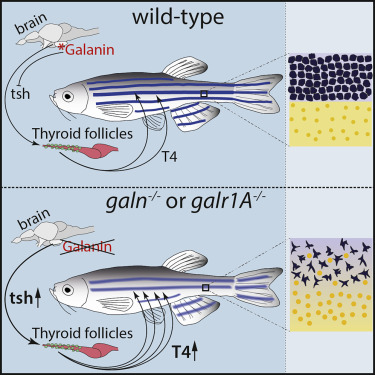当前位置:
X-MOL 学术
›
Curr. Biol.
›
论文详情
Our official English website, www.x-mol.net, welcomes your
feedback! (Note: you will need to create a separate account there.)
Galanin Signaling in the Brain Regulates Color Pattern Formation in Zebrafish.
Current Biology ( IF 8.1 ) Pub Date : 2020-01-02 , DOI: 10.1016/j.cub.2019.11.033 Anastasia Eskova 1 , Hans Georg Frohnhöfer 1 , Christiane Nüsslein-Volhard 1 , Uwe Irion 1
Current Biology ( IF 8.1 ) Pub Date : 2020-01-02 , DOI: 10.1016/j.cub.2019.11.033 Anastasia Eskova 1 , Hans Georg Frohnhöfer 1 , Christiane Nüsslein-Volhard 1 , Uwe Irion 1
Affiliation

|
Color patterns are prominent features of many animals and are of high evolutionary relevance. In basal vertebrates, color patterns are composed of specialized pigment cells that arrange in multilayered mosaics in the skin. Zebrafish (Danio rerio), the preeminent model system for vertebrate color pattern formation, allows genetic screens as powerful approaches to identify novel functions in a complex biological system. Adult zebrafish display a series of blue and golden horizontal stripes, composed of black melanophores, silvery or blue iridophores, and yellow xanthophores. This stereotyped pattern is generated by self-organization involving direct cell contacts between all three types of pigment cells mediated by integral membrane proteins [1-5]. Here, we show that neuropeptide signaling impairs the striped pattern in a global manner. Mutations in the genes coding either for galanin receptor 1A (npm/galr1A) or for its ligand galanin (galn) result in fewer stripes, a pale appearance, and the mixing of cell types, thus resembling mutants with thyroid hypertrophy [6]. Zebrafish chimeras obtained by transplantations of npm/galr1A mutant blastula cells indicate that mutant pigment cells of all three types can contribute to a normal striped pattern in the appropriate host. However, loss of galr1A expression in a specific region of the brain is sufficient to cause the mutant phenotype in an otherwise wild-type fish. Increased thyroid hormone levels in mutant fish suggest that galanin signaling through Galr1A in the pituitary is an upstream regulator of the thyroid hormone pathway, which in turn promotes precise interactions of pigment cells during color pattern formation.
中文翻译:

脑中的甘丙肽信号调节斑马鱼的颜色模式形成。
颜色图案是许多动物的突出特征,并且具有高度的进化意义。在基础脊椎动物中,颜色图案由专门的色素细胞组成,这些色素细胞排列在皮肤的多层镶嵌物中。斑马鱼(Danio rerio)是脊椎动物颜色图案形成的杰出模型系统,它使遗传筛选成为识别复杂生物系统中新功能的有力方法。成年斑马鱼显示出一系列蓝色和金色的水平条纹,由黑色的黑色素细胞,银色或蓝色的虹膜植物和黄色的黄细胞菌组成。这种定型模式是通过自组织产生的,该自组织涉及由完整膜蛋白介导的所有三种类型的色素细胞之间的直接细胞接触[1-5]。在这里,我们表明神经肽信号以整体方式损害条纹的模式。编码甘丙肽受体1A(npm / galr1A)或其配体甘丙肽(galn)的基因中的突变导致条纹减少,外观苍白,细胞类型混合,从而类似于具有甲状腺肥大的突变体[6]。通过npm / galr1A突变囊泡细胞的移植获得的斑马鱼嵌合体表明,所有三种类型的突变色素细胞都可以在适当的宿主中促进正常的条纹模式。但是,galr1A在大脑特定区域的表达缺失足以引起野生型鱼类的突变表型。突变鱼类中甲状腺激素水平的升高表明,垂体中通过Galr1A的甘丙肽信号传导是甲状腺激素途径的上游调节剂,进而促进了色素细胞在颜色模式形成过程中的精确相互作用。
更新日期:2020-01-02
中文翻译:

脑中的甘丙肽信号调节斑马鱼的颜色模式形成。
颜色图案是许多动物的突出特征,并且具有高度的进化意义。在基础脊椎动物中,颜色图案由专门的色素细胞组成,这些色素细胞排列在皮肤的多层镶嵌物中。斑马鱼(Danio rerio)是脊椎动物颜色图案形成的杰出模型系统,它使遗传筛选成为识别复杂生物系统中新功能的有力方法。成年斑马鱼显示出一系列蓝色和金色的水平条纹,由黑色的黑色素细胞,银色或蓝色的虹膜植物和黄色的黄细胞菌组成。这种定型模式是通过自组织产生的,该自组织涉及由完整膜蛋白介导的所有三种类型的色素细胞之间的直接细胞接触[1-5]。在这里,我们表明神经肽信号以整体方式损害条纹的模式。编码甘丙肽受体1A(npm / galr1A)或其配体甘丙肽(galn)的基因中的突变导致条纹减少,外观苍白,细胞类型混合,从而类似于具有甲状腺肥大的突变体[6]。通过npm / galr1A突变囊泡细胞的移植获得的斑马鱼嵌合体表明,所有三种类型的突变色素细胞都可以在适当的宿主中促进正常的条纹模式。但是,galr1A在大脑特定区域的表达缺失足以引起野生型鱼类的突变表型。突变鱼类中甲状腺激素水平的升高表明,垂体中通过Galr1A的甘丙肽信号传导是甲状腺激素途径的上游调节剂,进而促进了色素细胞在颜色模式形成过程中的精确相互作用。











































 京公网安备 11010802027423号
京公网安备 11010802027423号